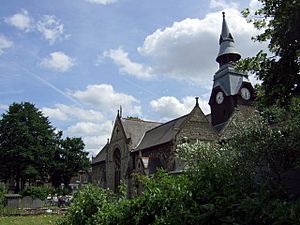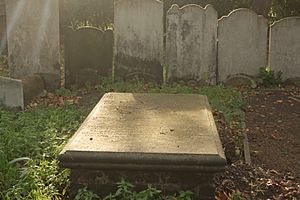St Matthias Old Church facts for kids
Quick facts for kids St Matthias Old Church |
|
|---|---|
 |
|
| Location | Poplar High Street, Poplar, London |
| Country | England |
| Denomination | Church of England |
| Architecture | |
| Architect(s) | Robert Shirley William Milford Teulon |
St Matthias Old Church is a very old and important building in Poplar, a part of London. It was originally known as Poplar Chapel. This chapel was built in 1654 by a powerful trading company called the East India Company. Today, St Matthias Old Church is recognized as a Grade II* listed building, which means it's a special historic place that needs to be protected.
This church is quite unique because it's one of the few churches still standing that was built during the time of the Commonwealth of England, a period when England was not ruled by a king.
Contents
A Look Back: History of St Matthias Old Church
Why the Chapel Was Built
In 1627, the East India Company (EIC) bought a house in Poplar. They wanted to use it as a hospital for sailors who were injured or sick. The EIC had a large shipyard in Blackwall since 1614. Because of this, many of their workers lived nearby in Poplar and Blackwall.
In 1633, these residents asked the EIC to build a chapel. The main church, St Dunstan's, Stepney, was too far away for them to easily attend services. A man named Gilbert Dethick, who was a local leader, also left money in 1639 to help build the chapel. He said the work had to start within three years of his death.
Building During Difficult Times
The construction of the chapel began around the same time as the English Civil War. This was a very troubled period in England's history. Despite the war, work on the chapel really got going in 1652. This was possible thanks to more money from Sir John Gayer, a director of the EIC, and funds directly from the company.
The first payment for the building was made in 1654 to John Tanner. He was the head of the Bricklayers' Company and became the main builder. A burial ground was also set aside for the chapel in 1657.
The Church's Design: Architecture
St Matthias Old Church is built mostly from brick. It has stone blocks at its corners, which are called quoins. The building mixes two different styles: Classical and Gothic. This is similar to another church in London called St Katherine Cree.
Inside the Church
Inside, the roof is shaped like a half-cylinder, which is called a barrel-vaulted roof. This roof is held up by eight large columns. Seven of these columns are made of oak wood, and one is made of stone. Some people used to say they were made from old ship masts, but there's no proof of that. The design of the interior has a Dutch feel, similar to churches built by Hendrick de Keyser in Amsterdam a long time ago.
Changes Over the Years
Over the 1700s, several changes were made to the church. A tower was added in 1718. In 1733, a special three-level pulpit was installed. The windows were also repaired and changed a lot between 1775 and 1776 by an architect named Richard Jupp. Later, in the early 1800s, a memorial for George Steevens was created by a famous sculptor, John Flaxman. This memorial is now on loan to the Fitzwilliam Museum in Cambridge.
How the Church Was Used
A Place for Travelers and Pensioners
For many years, Poplar Chapel was a very important place for sailors and passengers. They would come here to pray before starting long and often dangerous sea voyages. Many early settlers heading to British North America would have attended services here before leaving for their new lives.
The chapel also served the nearby almshouses. These were homes for the "Poplar Pensioners," who were seamen retired from the East India Company. Officers lived in different homes closer to the East India Dock Road, while other sailors lived on Poplar High Street. Between 1841 and 1844, eight Asiatic sailors were buried in the churchyard.
Becoming a Parish Church and Later Uses
After the Indian Rebellion of 1857, the East India Company was closed down. Poplar Chapel then became a regular Church of England parish church and was renamed St Matthias. Its first vicar (a type of priest) was John Fenwick Kitto.
From 1867 to 1876, a lot of changes were made by an architect named William Milford Teulon. A new pulpit, a font (for baptisms), and an organ were put in. The outside of the building was covered with a type of stone called Kentish ragstone. New sections like a chancel (the area around the altar), a vestry (a room for clergy), and an organ chamber were added. In 1920, beautiful stained glass windows were installed. These windows included symbols related to freemasonry and were a memorial to people who had died in the First World War.
During the Second World War, Poplar was heavily bombed in what was known as the London Blitz. However, St Matthias Church survived with only small pieces of metal (shrapnel) buried in its walls.
In the 1970s, St Matthias Church joined with another church, St Anne's in Limehouse. Even though St Matthias had many people attending, St Anne's was a very important building that couldn't be closed. So, the people from St Matthias moved to St Anne's. The St Matthias building was no longer used as a church after 1977.
After being empty for several years, English Heritage and the London Docklands Development Corporation (LDDC) decided to restore the building in 1990. They planned for it to be an "Arts Centre." In 1992, the St Matthias Conservation Trust was created. This trust helps to keep the building safe and uses it as a community center for local people.
People Buried at St Matthias
Many notable people have been buried at St Matthias Old Church over the centuries:
- Robert Ainsworth (died 1743)
- Mary East (died 1780)
- John Perry (died 1810)
- John Stock (died 1842)
- George Green (died 1849)
More Information
- A page from Tower Hamlets History Online with a detailed history
- History at St Matthias Community Centre website



